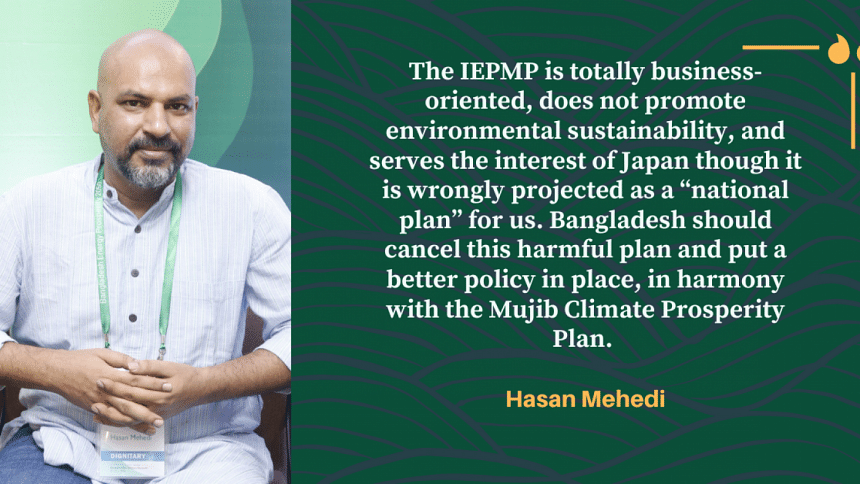‘The IEPMP serves Japan’s interest over Bangladesh’

In light of widespread discussions to overcome the ongoing power crisis, Hasan Mehedi, chief executive at Coastal Livelihood and Environmental Action Network (CLEAN) and member secretary of Bangladesh Working Group on Ecology and Development (BWGED), speaks to Ramisa Rob of The Daily Star regarding the proposed Integrated Energy and Power Master Plan (IEPMP), and why it's a step in the wrong direction in terms of Bangladesh's renewable energy goals.
What is the IEPMP and what are the main concerns about it?
The Institute of Energy Economics, Japan (IEEJ) is currently formulating the Integrated Energy and Power Master Plan (IEPMP) for Bangladesh with assistance from the Japan International Cooperation Agency (Jica). With the ongoing power crisis caused by the dependency on fossil fuels, it is crucial that we prioritise energy from renewables. The makers of this plan claim it to be a "long-term plan for affordable and stable fuel supply, and to promote low-carbon energy supply and demand systems," but in reality, it's a climate-conscious facade. Due to the lack of transparency, the stakeholders don't know much about it or understand how problematic it is. We, at CLEAN and BGWED, recently sent a policy brief to the state minister of power and the parliamentary standing committees that we are against the approval of this plan. We have not heard back from them, but this plan is a huge step backwards, and it must be halted.
There are four main concerns about the IEPMP. First, no Bangladeshi experts are involved in it. The Japanese experts overestimated the demand with a linear analysis, calculating it against the GDP. It is a misguided approach as the main consumers of power are the informal sectors of Bangladesh's economy. There has also been no consultation with different sides and sectors of energy users at the regional level. Of the installed capacity in the power sector, the plan proposed 30.7 percent to be fossil fuels (coal and LNG) and 32.8 percent to be the so-called Advanced Technology (liquid hydrogen, ammonia, and carbon capture and storage) by 2050. This will further ensure that Bangladesh remains fully dependent on other nations. Our energy self-sufficiency will be violated if we go through with this. And most importantly, the IEPMP completely contradicts the approved Mujib Climate Prosperity Plan (MCCP), which targets achieving 100 percent of energy from renewables by 2050. The prime minister echoed the target of 40 percent by 2041, during the UN Climate Conference (COP26) in December 2021. But the IEPMP claims to target only 17.1 percent renewables by 2050 – which is overtly unaligned with the MCCP.
What is this "Advanced Technology" that the IEPMP promotes, and why is it not a positive shift away from the dependency on coal-based power plants?
The Advanced Technology is what we call "greenwashing." It uses liquid hydrogen, ammonia and CCS, which, taken together, have not been proven to reduce carbon emissions. In fact, developed nations, namely the US, Canada and the UK, rejected purchasing this unproven technology. We are still a Least Developed Country and we have to think about the affordability of power and energy. This technology will be three to four times more expensive than coal. We will also need a lot of electricity to produce hydrogen itself, which will take Tk 269 per kg nowadays. So counterproductively, we will be extending the life of coal and fossil gas, and over time, it will cost an estimated $180 billion to import this technology till 2050, which is completely unrealistic.
We have more viable options of transitioning to solar and wind energy, which are proven and significantly cheaper. But it seems that the government is more interested in supporting the Japanese firm Jica, which also funded the 2016 Power System Master Plan, which called for a major rollout of power stations to be fuelled by imported coal and liquefied natural gas (LNG). Interestingly, LNG and coal energy-fired generation were technologies that Japan was keen to sell. Japan is our largest bilateral partner and Bangladesh is an easy target for Japan to sell the technology that no other developed nation is willing to purchase. The IEPMP is totally business-oriented, does not promote environmental sustainability, and serves the interests of Japan, though it is wrongly projected to be a "national plan" for us. This is why Bangladesh should cancel this unfeasible and harmful plan and put a better policy in place, a plan that is in harmony with the Mujib Climate Prosperity Plan.
When formulating a new viable policy, what are the challenges that we have to overcome, and where should the focus be?
Bangladesh is facing a serious overcapacity problem in the power sector. We should urgently look to replace and phase out fossil-fuel-fired power plants and transition to solar and wind energy, which most importantly do not have capacity charges. We all know the financial burden that capacity charges pose on the economy. Bangladesh has not been able to prioritise the renewable energy targets that have been announced because, in my opinion, there is a lobby among policymakers who want to maintain the 18th-19th century technology of fossil fuels. But there is also strong interest in the ruling party to shift towards renewable energy, and I personally witnessed it from various members of parliament, too.
Bangladesh has a high capacity for solar power generation, of 20,000-40,000MW of solar power, as stated in the 2021 draft of the National Solar Energy Roadmap. It has not been approved yet due to the powerful fossil fuel lobby. The US-based National Renewable Energy Laboratory performed a recent study, which found that Bangladesh also has a capacity for 30,000MW of onshore wind energy. So the question we should be asking to guide our future plans is quite clear: do we really need LNG and coal?
Not only is it climate-friendly, but solar energy is also very economically feasible. So for example, if we allocate Tk 24,000 crore only for the power sector each year, and just allocate Tk 3,500 crore of that allocation to solar, we can reach the target in the MCCP by 2050. On the other hand, if we allocate the entire Tk 24,000 crore to solar, we can implement a whopping 3,000MW of solar power each year. Solar panel price is going down by 10 percent every year and the battery price is decreasing by 15 percent every year due to technological advancement. We don't have to think about the "base load" of batteries until 2035, and we can start thinking about battery storage through research and modelling. For now, we have to find a way to use the idle power plants that the government has invested in to implement our renewable energy goals. This way, we can phase out the dependency on fossil-fuel-based power plants as well. And we do have to phase them out, as I see that around four to five power plants will reach the end of their lifetimes this year. So when that happens, we need to replace them with solar plants, and by continuing that process, we can gradually progress towards our renewable energy target.

 For all latest news, follow The Daily Star's Google News channel.
For all latest news, follow The Daily Star's Google News channel. 








Comments